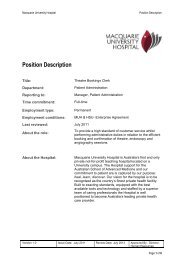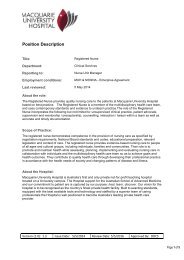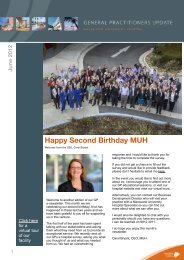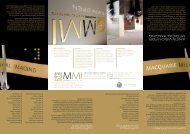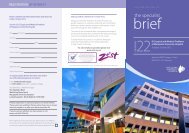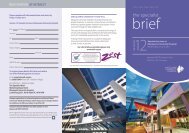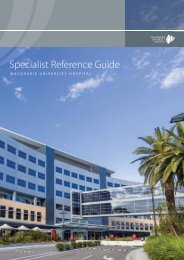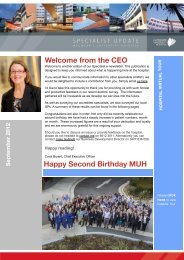Plenary Oral Presentations - Macquarie University Hospital
Plenary Oral Presentations - Macquarie University Hospital
Plenary Oral Presentations - Macquarie University Hospital
Create successful ePaper yourself
Turn your PDF publications into a flip-book with our unique Google optimized e-Paper software.
16 th International Meeting of the Leksell Gamma Knife ® SocietyMarch 2012, Sydney, AustraliaPH-191Inter- and intra-fraction performance of the Gamma KnifeExtend System for patient positioning and immobilizationDavid Schlesinger, Chun-Po Yen, Zhiyuan Xu, Jason Sheehan<strong>University</strong> of VirginiaObjective: The Gamma Knife Extend System makes possible multi-fraction Gamma Knife treatments.The Extend System consists of a vacuum-monitored immobilization frame and a positioning measurementsystem to determine the location of the patient’s head within the frame at the time of simulationimaging and before each treatment fraction. The measurement system consists of a RepositioningCheck Tool (RCT) that attaches to the Extend frame, and associated digital measuring gauges. Thepurpose of this study is to evaluate the pre-fraction repositioning and intra-fraction immobilizationperformance of the Extend System for the first ten patients (n=36 fractions) treated at the <strong>University</strong>of Virginia.Methods: For each patient, the RCT was used to acquire a set of reference measurements of thepatient’s position at the time of CT simulation. Before each fraction repositioning measurements wereacquired, and the patient position was adjusted until the residual radial difference from the referenceposition measurements were less than 1mm (if possible). After treatment, position measurements wereacquired and the difference from the pre-fraction position was calculated as a measure of immobilizationcapability.Analysis of patient setup and immobilization performance included calculation of group mean, standarddeviation (SD), and distribution of systematic (components affecting all fractions) and random(per-fraction) uncertainty components.Results: Across all patients and fractions, the achieved mean radial setup difference from the referencemeasurements was 0.65mm, SD=0.24mm. The distribution of systematic uncertainty was 0.17mm.The distribution of random uncertainty was 0.16mm. The RMS differences for each plate wereright=0.35mm; left=0.41mm; superior=0.28mm; anterior=0.20mm.The mean intrafractional positional difference across all treatments was 0.46mm, SD=0.30mm. Thedistribution of systematic uncertainty was 0.19mm. The distribution of random uncertainty was0.22mm. One treatment fraction was excluded from the analysis because the vacuum monitoringinterlock detected patient motion, requiring mid-fraction repositioning.Conclusions: With appropriate patient selection, the Extend system can be used to reposition patientswith sub-millimeter precision, and appears to have adequate immobilization capability. However, careshould be taken to acquire measurements that can implicitly account for rotations of the patient’shead. Further work is required to determine the sensitivity of the vacuum interlock to detect patientmotion.60



